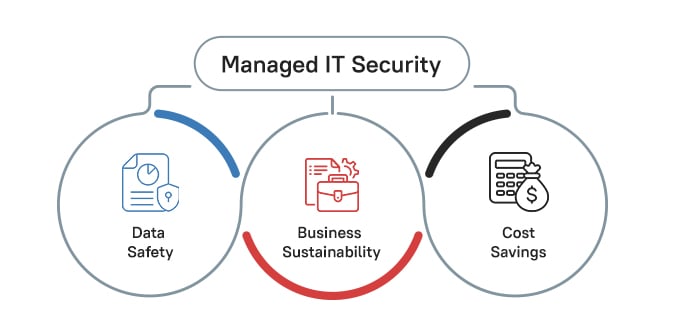The process of preventing attacks on your IT Infrastructure is never a one-time assignment. On the contrary, it is an ongoing, consistent string of efforts. Cybersecurity is one of the most significant issues facing businesses today. In addition to being a huge drain on a company’s resources, a breach can have serious consequences for business sustainability.
By detecting and mitigating data breaches and compliance gaps well in advance, organizations can potentially prevent high costs, stick to their budgets, and stay aligned with costs.
Moreover, even common cybersecurity threats are constantly evolving, and businesses must keep pace with change. Otherwise, they will likely suffer several times unless they adopt more stringent security measures.
According to a recent IBM report, the average data breach cost in the US is $9.44 million. According to online reports, the average cost of a breach for organizations with high compliance failures is $5.57M.
A Forbes report says that ransomware cost the world $20 billion in 2021. That number is expected to rise to $265 billion by 2031. On average, recovery from a ransomware attack cost a business $1.85 million in 2021.

The Costs of Failing to Secure Your Network are High
The costs of failing to secure business networks and repair damage are often high. In addition to the financial damage of a cyberattack, there can be damage to a business’s reputation, which can in turn impact sales, customer trust, and loyalty.
Furthermore, businesses need to consider the cost of time and resources that are spent on recovery measures. These measures can include notifying all stakeholders, including customers and investors, to ensure adequate containment of the damage incurred. Business costs will also need to be factored into implementing new security measures. This could be in terms of additional software protection, or additional measures such as encryption or ‘authorized access only’ points within the organization.
Why Choose Professional Assistance?
a. Consistent Monitoring: Professionally managed network security services are critical to ambitious businesses because IT security is a constant process. This is also because technology constantly evolves and new threats are constantly arising. Security professionals need to be on the lookout for new ways to protect their businesses from these threats. It is no longer safe for businesses to install simple antivirus software or a firewall and assume their network is fully protected. Continual monitoring of systems is essential to catch activity changes or stay abreast of new and upcoming security threats. Regular checks by managed cybersecurity services also reveal vulnerabilities, which can prompt businesses to take immediate action before hackers can exploit them. Penetration testing can often help uncover vulnerabilities.
b. Staying abreast of new developments: IT providers should be able to help businesses stay on top of threats. Professionals who provide outsourced cybersecurity services are typically aware of the latest trends and best-in-industry security trends and technology. This knowledge allows them to provide their clients with robust and updated security cover. Professional assistance enables businesses to protect their data, infrastructure, and systems and ensure their in-house resources are trained and updated in cybersecurity and other protection measures.
c. Ensuring compliance with best practices: Professional assistance can help ensure businesses are on top of technology and cybersecurity practices. Some of the other ways in which they ensure this are:
- Updating to the latest security patches to ensure that malicious attacks don’t get into the system through any bugs.
- Updating operating systems and software regularly to cover vulnerabilities and gaps.
- Upgrade and replace outdated hardware with new models that include built-in and new security features.
Next Steps
- Learn more about the benefits of professionally managed IT services, including security solutions, and how we can help boost your business profitability at https://www.analytix.com/
- Please email us at sales@analytix.com or call 781.503.9003 today.
- Follow our blog for industry trends and the latest updates.
- Engage with us on LinkedIn and Twitter.
